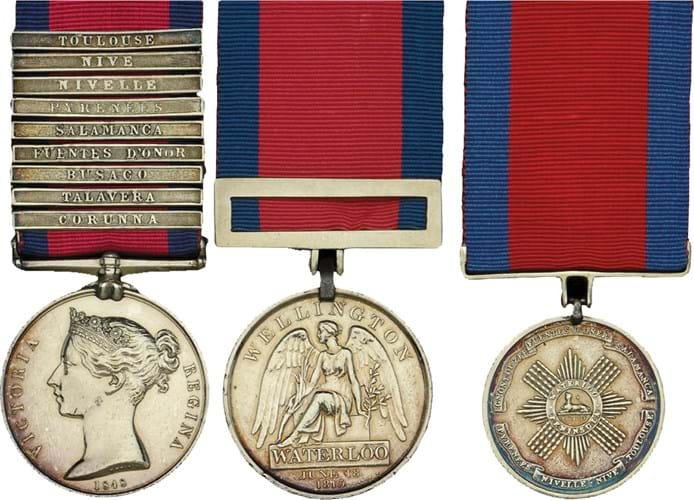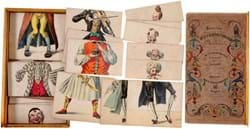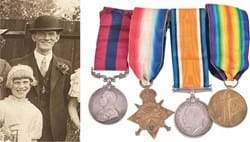Campaign medals, by their very nature, are common for the biggest wars. Given to all who served, they need that extra touch to gain value.
Sometimes it is the identity of the recipient (winner of top gallantry honours as well, for example), or perhaps the clasps on the ribbon showing the individual battle honours.
The Waterloo Medal (1815) was the first such British campaign honour awarded and officially named to all ranks who took part in the 1815 campaign (it also includes the actions at Ligny and Quatre Bras just before the main battle).
With 39,000 given out, the factors boosting value also include the regiment of the recipient – those most heavily involved and took the highest casualties will be most popular, such as the Scots Greys, and those that took part in the must famous engagements in the battle. The medals were also given to next of kin of those who died.
General Colville’s division, kept in reserve and out of the action, is generally the least sought after.
Given their ubiquity, a regular Waterloo Medal will often make around £1000-1500.
Unique award
An ideal example of a higher-value Waterloo Medal came up in the Charterhouse (25% buyer’s premium) two-day Militaria, Coins and Stamps auction in Sherborne, Dorset on December 1.
It included militaria from three soldiering generations of a family: with three groups of medals awarded to the Evatts, all of which were found in a small box when a thatched cottage was being cleared. They were consigned by family descent.
One of the family group honours at Charterhouse was awarded to Major George Evatt, 55th Foot. Estimated at £4000-6000, it sold for £12,000. The condition was described as ‘wonderful’.
Key to the result was the fact that Evatt was the only member of the 55th Foot to serve at Waterloo, making this a unique award.
A 1917 letter to Notes and Queries, Series 12, Vol 3, by a George JH Evatt (surgeon-general, Junior US Club, Charles Street, St James’s) says: “When Wellington’s army advanced to Paris in 1815, my grand-uncle Major George Evatt, 55th Foot, Assistant-Adjutant-General at Waterloo, and recipient of the Waterloo Medal, was appointed Commandant de Place for English and Hanoverian troops left behind at Brussels.
“He is the ‘Major Evatt’ referred to by the Duke of Wellington in his letter to the Duchess of Richmond (written from Paris) as to the sick and wounded soldiers at Brussels; see Wellington’s ‘Correspondence,’ 1815.
“In 1816 Major Evatt was promoted to lieutenant-colonel, and later to colonel, and died in 1840 as Commandant of the Royal Military Asylum at Southampton. His brother Capt. John Hamilton Evatt, 57th Foot, commanded No. 7 company of that regiment at Albuera, 1811. Capt. Evatt’s great-grandson, my son Capt. G. R. K. Evatt, 1st Middlesex Regiment, late 57th Foot, was killed in action in the trenches at La Boutillerie, 3 miles south of Armentieres, North France, Nov. 14, 1914, commanding “A” company in his great-grand- father’s regiment, the old 57th Foot, “the Die-Hards”.”
Battle hardened
Sold at £5200 against an estimate of £3000-3200 in Bosleys’ (22% buyer’s premium) of Marlow on December 14 was another example of how this common award can gain value.
It was given to Capt Edward H Frederick, 51st Regiment Light Infantry. The regiment played only a relatively minor role at Waterloo on the extreme right flank overlooking Hougoumont farm (where there was fierce fighting).
However, the original ribbon was fitted with contemporary unofficial clasps for battle honours for Corunna, Wacheren, Fuentes D’Onor, Salamanca, Vittoria and Pyrenees, indicating a very distinguished service record before Waterloo in the Peninsular War and the ill-fated Walcheren expedition of 1809.
Captain Frederick (1784-1866) is confirmed on the Waterloo Medal roll as a company commander (the roll is the primary source of names of British soldiers who fought in the battle). He was appointed a Companion of the Order of the Bath in 1838 at that time serving with the rank of lieutenant general. In the British Indian Army he was Commissary General of the Bombay Army. He later became a general.
Impressive trio
Peninsular honours also boosted a group of three medals awarded to Private Donald Ross who served with the 1st Bn, 79th Regt Foot in the battle.
While his Waterloo Medal did not feature any clasps, his accompanying Military General Service (MGS) medal 1793-1814 (applied for retrospectively) included nine Peninsular battle honours. The other honour was a 79th Foot Order of Merit for 12 years’ service. He was also present at Quatre Bras in the Waterloo campaign.
Ross’ group was estimated at £4000-6000 in the Noonans (24% buyer’s premium) auction in Mayfair on December 7 and sold for £8500.
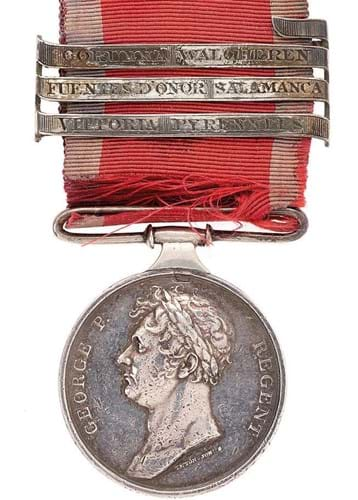
Military General Service medal 1793-1814 awarded to Waterloo veteran Captain David Davies, 32nd Regt, in a group including two Waterloo Medals sold for £8000 at Noonans.
In the same auction a very unusual double-issue Waterloo Medal and an MGS honur awarded to Captain David Davies, 32nd Regiment, later Brevet Lieutenant-Colonel in the 45th Foot, who was slightly wounded at Quatre Bras and severely wounded at Waterloo, took £8000 (guide £5000-7000). The MGS had four Peninsular clasps.
After helping to halt the French attack at Quatre Bras, the 32nd Regt stood their ground against the main enemy attacks at Waterloo then counter attacked (the 1st Battalion of the regiment was part of the 8th British Brigade commanded by Major-General James Kempt, which was in turn part of the 5th British Infantry Division under Lt-Gen Thomas Picton, killed in action).
The double issue came about because Davies’ name had been returned in error on both the staff and regimental rolls.
Thick of the action
The Waterloo Medal awarded to Lieutenant H Martin, 44th (East Essex) Regiment of Foot, sold for £9000 at London saleroom Spink (20% buyer’s premium) on November 24.
In 1814, in a badly managed attack at Bergen-op-Zoom which underestimated the size and resolve of the French defenders, over 2000 of the British force (half its strength) were killed, wounded or captured – and among the wounded was then Ensign Henry Martin.
A year later, as part of Picton’s division rushed into action at Quatre Bras on June 16, the 44th were soon in the thick of the fighting and at one point things became desperate when the battalion was charged by a regiment of French lancers which had been concealed in a dip in the ground.
At Waterloo the division found themselves posted to the very centre of Wellington’s line. Brigaded with the 92nd (Gordon) Highlanders, the 44th opposed Marcognet’s column during d’Erlon’s vast infantry assault and Martin would have shortly after witnessed at close-hand the famous charge of the Scots Greys.
By the end of the battle the 44th had their commanding officer, all the captains, all but three of the ensigns and two of the 11 lieutenants wounded.
Martin later penned a swift but fascinating account of his experiences at the battles of June 16-18 which was prized by his family back home.
Accessible price range
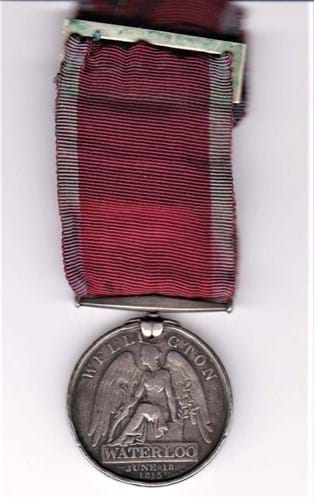
Waterloo Medal of Thomas Wilson 1st Battalion, 71st Regiment of Foot (Highlanders), £1050 at James & Sons.
On the other hand, the number of Waterloo medals does, of course, mean that plenty of still fascinating options (especially for research) are available to collectors at a lower price range.
James & Sons (20% buyer’s premium inc VAT) of Fakenham, Norfolk, offered a Waterloo Medal on December 14, named to Thomas Wilson 1st Battalion, 71st Regiment of Foot (Highlanders).
The unit saw action as part of the 3rd Brigade; the 1st Bn serving in Captain Archibald Armstrong’s company and suffering one officer and 24 other ranks killed, and 14 officers and 160 rank and file wounded.
It sold for a mid-estimate £1050. Auctioneer David James said: “This is the eighth Waterloo Medal we have sold in recent times and they always attract a lot of attention.”



